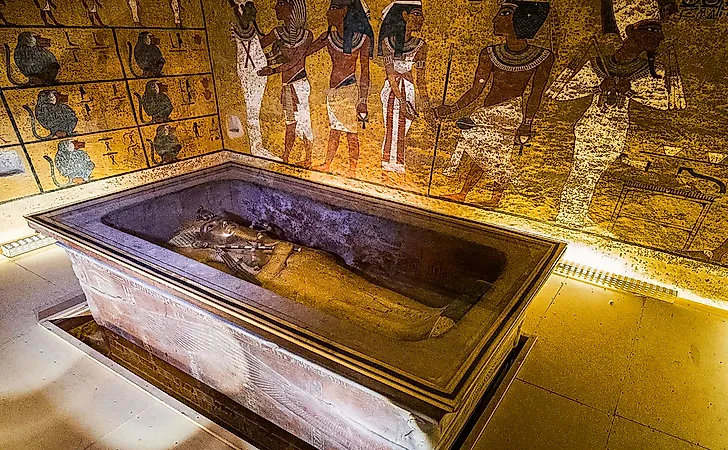10 Interesting Facts About King Tut

King Tut or Tutankhamun was an Egyptian pharaoh who lived from around 1341 to 1323 BC. Tutankhaten was his first name, and it means "the living image of Aten" while the name Tutankhamun means "the living image of Amun." Aten and Amun were ancient Egyptian deities. Howard Carter discovered the tomb of Tutankhamun in 1922 almost by accident and found it nearly intact. It is believed that he was born in Akhenaten, the capital of ancient Egypt. His father was known as Akhenaten, and his mother was his father's sister. He became the King of Egypt at the age of 9 and married his half-sister, who was known as Ankhesenpaaten. He changed his name to Tutankhamun three after taking the reign as a king. It has been speculated that he was assassinated while others believe that his death could have been as a result of an accident.
He became a king when he was a boy
Tutankhamun's father died when he was only seven years old. Two years later, he became pharaoh and married his half-sister. Since he was too young to judge independently, most of his decisions as a king were made on his behalf by his viziers.
King Tut changed his religion and his name
Before the rule of King Tut's father, Amun was the main deity worshipped by the Egyptians. During his father's reign, the Sun God Aten was given more importance. However, King Tut reverted to the old religion once he came to power. Ay, his chief advisor during his early years as a king, is believed to have influenced his decision in this regard. It is also the primary reason why he changed his name. The act made him more popular among his subjects who had not been too happy with the religious reforms introduced by their previous king.
The suspected assassin of the King
Horemheb was one of the chief advisors of Tut. He is also suspected of having assassinated Tut. He became the Pharaoh of Egypt after the death of the first successor of Tut. After coming to power, Horemheb ruined all the available records of his immediate predecessors and put his name on all monuments. To some extent, he succeeded as the previous kings were almost completely forgotten for several centuries until the chance discovery of King Tut's tomb in the 20th century.
He had a terrible accident
Inspection of the mummy of King Tut revealed that he was involved in some grave accident that shattered his rib cage, damaged his internal organs, and broke his pelvis. The injuries were similar to that seen in victims of car accidents in the modern-day. Since chariots were a popular means of traveling in ancient Egypt, it is possible that King Tut sustained injuries when he met with an accident while racing his chariot through the desert. Whether this was the primary reason for his death is yet to be elucidated.
Other Speculations about his death
Malaria attacks and broken bone disorders have also been suspected to cause the death of King Tut.
He had stillborn twins
According to the evidence collected from the tomb, King Tut and his wife had daughters. The remains of the twin daughters were discovered in his burial place. It is evident that their daughters were stillborn and the DNA tests showed that at least one of them had a skeletal deformity
King's Tut's mummy was charred
When his tomb was discovered, the mummified body of King Tut appeared charred like a body that had been consumed in flames. According to archaeologists, black resins and oils in the coffin could have exploded upon exposure to oxygen and burned the body. It is not known why these items were present in the tomb.
To learn about the process of mummification, read here.
Strange dagger made of meteorite metal found in the tomb
When the tomb was opened, it was found to contain a dagger among several other items. The dagger was still exceptionally sharp after thousands of years. The origin of the dagger is shrouded in mystery and controversy. However, tests reveal that the metal came from a meteorite. The ancient Egyptians did not have the technology of making a dagger out of meteorite debris, and therefore, it is believed that it could have come from another more advanced civilization, or even as others have theorized could have been left behind by some aliens.
His heart was missing
According to ancient Egyptians, the organ for reasoning was the heart and not the brain, and therefore, it was still essential for afterlife. Typically, the heart would be preserved, but in the case of Tut, the heart was missing in his mummy. It has been theorized that possibly Tut died when he was far away from home so that by the time they got his body for embalming the heart had already deteriorated so much that it could not be preserved and they had to get rid of it.
Burial jars of King Tut's tomb were unique
When embalming a body, organs such as the lungs, intestines, stomach, and liver, would typically be removed from the body and stored in special jars known as canopic jars. It was believed in ancient Egypt that it was essential to take organs to the afterlife, and therefore, they were carefully preserved. The jars for such organs had lids carved to symbolize each of the sons of Horus who were gods. The organs were kept in these canopic jars. Interestingly, the canopic jar for Tut's organs was different because it was not carved to depict any of the gods, but rather it was in his likeness.
To learn some more interesting facts about Ancient Egypt and its people, read 10 Interesting Facts About Ancient Egyptians











